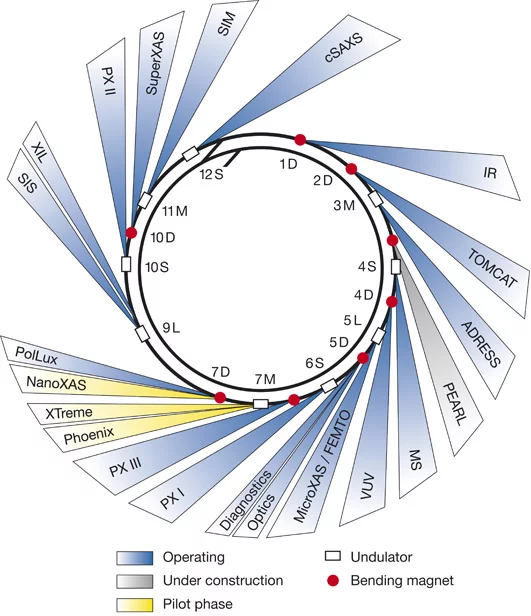The Swiss Light Source (SLS) at the Paul Scherrer Institut is a third-generation synchrotron light source. In the design of SLS a high priority was given to the items quality (high brightness), flexibility (wide wavelength spectrum) and stability (very stable temperature conditions) for the primary electron beam and the secondary photon beams.
With an energy of 2.4 GeV, it provides photon beams of high brightness for research in materials science, biology and chemistry.
Specialities of SLS
The SLS is a member of a network of light sources based on a storage ring. It is a state of the art facility producing beams of exceptional brightness and stability.
The SLS is the Swiss National Source, open for international research groups as well. It offers unique research opportunites to academic research teams as well as industrial research groups.
Some special features of SLS are:
- a very large spectrum of synchrotron light ranging from infrared light to hard X-rays
- a mixture of straight sections (short, medium and long), allowing an optimal use of a variety of undulators
- undulators with flexible polarization schemes, giving e.g. the possibility to rapidly change the polarization in the kHz range
- top-up injection, producing a constant beam intensity for experiments
- individual control of all magnet power supplies, giving optimal flexibility for the optical properties of the storage ring.
History and Specifications of the SLS
Planning started in 1991, project was approved in 1997, and first light from the storage ring was seen at December 15, 2000. The experimental program started in June 2001 and it is dedicated to research in materials science, biology and chemistry.
As of June 2009 SLS has eighteen experimental stations (undulators and bending magnets) and seventeen operational beamlines. There are three protein crystallography beam-lines, two of which are partially funded by associations of Swiss pharmaceutical companies including Novartis, Roche, Actelion, Boehringer Ingelheim and Proteros.
The 2.4 GeV electron storage ring of 288 m circumference is formed by 36 dipole magnets of 1.4 tesla magnetic field, combined in 12 groups of three (triple bend achromat, TBA) for achromatic deflection of the electron beam. 12 straight sections between the TBAs of different lengths (3×11.5 m, 3×7 m, 6×4 m) accommodate the undulator magnets to generate ultraviolet and X-ray light of extreme brightness. 3 of the dipoles have an increased center field of 3 teslas to produce hard X-rays. A total of 177 quadrupole magnets (magnetic lenses) focusses the beam to provide an emittance of 5.5 nm rad. 120 sextupole magnets correct the chromatic focusing errors of the quadrupoles. 73 horizontal and vertical beam steerers are used to continuously correct the position of the electron beam. Finally 24 skew quadrupole magnets are adjusted to correct any torsion of the beam and to minimize the vertical emittance: a world record low value of 3 pm rad has been achieved in 2008.
Further information
- News, information, and educational materials about the world’s synchrotron and free electron laser light source facilities lightsources.org
- Swiss Light Source Publications
- Scientific Highlights of Swiss Light Source

